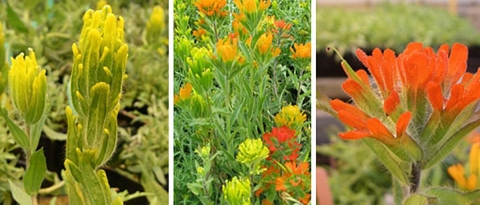Hybridization with harsh paintbrush (Castilleja hispida), one of the preferred host plants for the endangered Taylor’s checkerspot butterfly, poses a potential threat to golden paintbrush (C. levisecta), another species of conservation emphasis.
To minimize the potential for hybridization, the U.S. Fish and Wildlife Service, the Washington Department of Natural Resources and the Washington Department of Fish and Wildlife entered into a Memorandum of Understanding to adequately manage this threat to golden paintbrush, while harmonizing conservation efforts for both golden paintbrush and Taylor’s checkerspot butterfly. We developed a Hybridization Strategy and Guidance document to outline a landscape level, long-term strategy for outplanting golden paintbrush to support its conservation and outplanting harsh paintbrush to support Taylor’s checkerspot butterfly conservation.
The primary goals are:
1. To communicate the issue of hybridization as a potential threat to golden paintbrush
2. To outline solutions necessary for the long-term protection of golden paintbrush and the use of harsh paintbrush as a larval host plant for Taylor’s Checkerspot Butterfly in WA.
3. To provide specific information on sites, geographic areas, and proximity guidelines needed to implement the outlined solutions.
Info sheet: Guidance and Best Practices for Planting Golden Paintbrush
Memorandum of Understanding
The Memorandum of Understanding is available here (PDF- 552 KB)
Hybridization Strategy
The full hybridization strategy is available here (PDF- 5.2 MB)
Overview of Recommended Solutions
| Prevent | Prevent hybridization in other geographic areas |
| Implement | Implement a decision-making framework |
| Manage | Actively manage sites with both paintbrush species or those that are hybridized |
| Map | Map the golden and harsh paintbrush distribution and refine active inventory |
| Adopt | Adopt decontamination procedures for multi-site prairie restoration activity |
| Formalize | Formalize seed production risk management |
| Disseminate | Disseminate information |
| Improve | Improve understanding of hybridization risk and its impact to species |
Maps of Regions
North Puget Lowlands (Island & San Juan Counties) (PDF- 1.4MB)
Olympic Peninsula (Clallam and Jefferson Counties) (PDF- 1.25MB)
South Puget Lowlands (Mason, Pierce, and Thurston Counties) (PDF- 1.25MB)
Southwest Washington (Clark, Cowlitz, and Lewis Counties) (PDF- 1.6MB)
Willamette Valley, Oregon (PDF- 712 KB)
Outplanting Proposals
If you are planning to outplant either golden paintbrush or harsh paintbrush and need to have your proposal reviewed (see Hybrid Guidance a Strategy document for decision flow charts), please use this form below. Please send proposals to FW1_paintbrush_hybridization@fws.gov.
Please anticipate 30-90 days for proposal review.
Outplanting Proposal Form (DOCX- 16 KB)
If you have questions about the Hybridization Strategy and Guidance, proposal submission and review process, or MOU, please contact:
Erin Gray
Endangered Species Biologist
U.S. Fish and Wildlife Service
erin_gray@fws.gov
Hannah Anderson
Wildlife Diversity Division Manager
Washington Department of Fish and Wildlife
h.anderson@dfw.wa.gov
Joe Rocchio
Program Manager, Natural Heritage Program
Washington Department of Natural Resources
joe.rocchio@dnr.wa.gov




